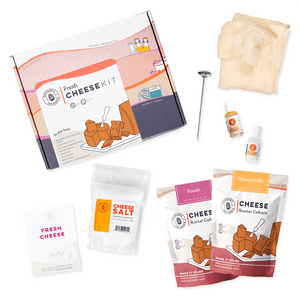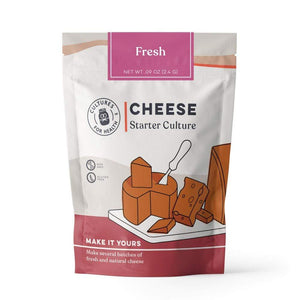
This is a great example of a natural-rind cheese. It can be eaten young (called fontinella), or left to age for a few months for a more sharp, mature taste. If you make this cheese in two molds, you can have one young while you wait on the other to fill out and mature.
15 minutes
120 minutes
5
INGREDIENTS AND EQUIPMENT AVAILABLE AT CULTURES FOR HEALTH
Fresh Cheese Making Kit

Fresh Cheese Making Kit
$45.99
Our most comprehensive choice, the Fresh Cheese Kit contains two starter cultures and supplies to make five different varieties of soft cheese - feta, cottage cheese, cream cheese, fromage blanc, and traditional quark. Kit contains a Mesophilic Cheese Culture, a Fresh Cheese Culture, calcium chloride, vegetable rennet, cheese salt, butter muslin, a thermometer, and an instruction and recipe booklet.
Packaging and Equipment in the kit may appear different than pictured.
Fresh Cheese Starter Culture

Fresh Cheese Starter Culture
$12.99
This versatile culture is used to make a wide range of soft cheeses, including cottage cheese, chevre, and even blue cheeses.
INGREDIENTS:
- 2 gallons whole cow milk
- 1/2 tsp. mesophilic starter
- 1/4 tsp. mild lipase powder diluted in 1/4 cup cool, unchlorinated water
- 1/2 tsp. calcium chloride diluted in 1/4 cup cool, unchlorinated water
- 1/2 tsp. liquid rennet diluted in 1/4 cool, unchlorinated water
- Cheese salt
INSTRUCTIONS:
- Heat the milk to 88°F, slowly, over about 15 minutes.
- Inoculate the milk by sprinkling the powdered starter over the surface of the milk and letting it sit there to rehydrate for 1 full minute before stirring it in with a cheese spoon in slow, steady, up-and-down motions. Cover the milk and let it sit undisturbed for 30 minutes to ripen.
- Add the lipase and use a whisk to incorporate for 1 full minute. Next, use the same method to add the calcium chloride and rennet. Cover and allow the milk to sit undisturbed at 88°F for 45 to 50 minutes, or until the curds give a clean break.
- Cut the curd into 1/4-inch cubes and stir them gently for 10 minutes. Maintain the temperature and let the curd sit undisturbed again, this time for 30 minutes. They will settle at the bottom of the pot during this time.
- Ladle off enough whey to where you can just see the tops of the curds. Pour in enough 145°F water to bring the overall temperature up to 102°F.
- Stir the curds continuously for 10 minutes. They will begin to knit and mat together, and they will decrease in size as they are being stirred. Gently clench a handful of curds in your hand. If they cling to each other when you do this, they are ready for the next step.
- Again, ladle off enough water to expose the curds. Using your hands, pack the curds into a damp 8-inch tomme mold lined with butter muslin or two small fresh cheese molds set on a draining rack. Fold the tails of the muslin over the tops of the curds. Press the cheese at 5 lbs. of pressure for 15 minutes, then remove the cheese from the mold, unwrap it, flip it over, rewrap it, and place it back into the mold and press at 15 lbs. for 8 hours.
- Make about half a gallon of medium brine and chill it. Take the cheese(s) out of the mold and unwrap them. Place them in a non-corrosive container and pour in the chilled brine. Cover tightly with a lid and place the whole thing in the refrigerator, and leave the cheese to soak there for about 12 hours.
- Take the cheese out of the brine and pat it dry with paper towels. Place it on a cheese mat and allow the cheese to dry at room temperature for 2 days, or until the surface is dry to the touch. Flip it periodically during the air-drying period.
-
Place in a cellar or ripening box and ripen at 55°F and 95% humidity for around 1-1/2 to 2 months. Wipe the cheese periodically with a piece of cheesecloth dampened in brine to deter mold. The cheese is ready to eat at 2 months, but can be aged for up to 6 months for a fuller flavor and personality.
















